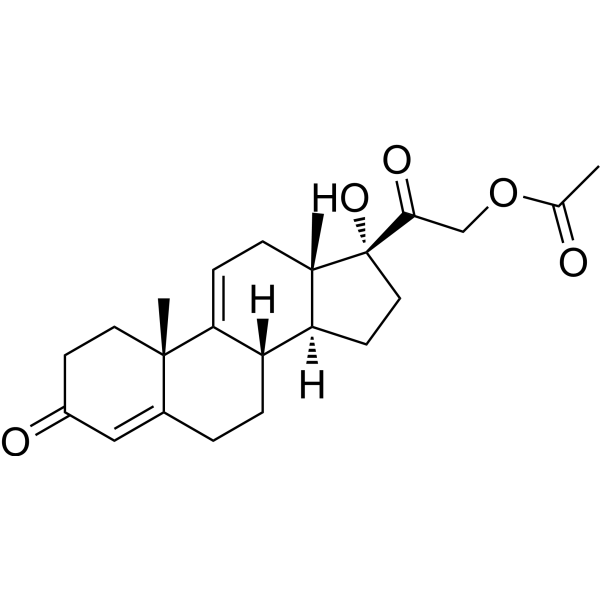
Anecortave Acetate
CAS No. 7753-60-8
Anecortave Acetate( Anecortave Acetate | Anecortave | Al 3789 | NSC 15475 | NSC 24345 | Retaane )
Catalog No. M27409 CAS No. 7753-60-8
Anecortave Acetate, an angiostatic steroid, is used for proteomics research.
Purity : >98% (HPLC)
 COA
COA
 Datasheet
Datasheet
 HNMR
HNMR
 HPLC
HPLC
 MSDS
MSDS
 Handing Instructions
Handing Instructions
| Size | Price / USD | Stock | Quantity |
| 5MG | 45 | Get Quote |


|
| 10MG | 63 | Get Quote |


|
| 25MG | 103 | Get Quote |


|
| 50MG | 150 | Get Quote |


|
| 100MG | 223 | Get Quote |


|
| 500MG | 482 | Get Quote |


|
| 1G | Get Quote | Get Quote |


|
Biological Information
-
Product NameAnecortave Acetate
-
NoteResearch use only, not for human use.
-
Brief DescriptionAnecortave Acetate, an angiostatic steroid, is used for proteomics research.
-
DescriptionAnecortave Acetate, an angiostatic steroid, is used for proteomics research.
-
In Vitro——
-
In VivoAnecortave acetate (5 μl of a 10% suspension; Injected into eyes) significantly inhibits pathologic retinal angiogenesis and increases PAI-1 mRNA levels. Animal Model:Sprague-Dawley albino rats (intravitreally injected with premixed antibiotics to influence retinal vessel growth) Dosage:5 μl of a 10% suspension of Anecortave acetate Administration:Injected into eyes Result:significantly inhibited pathologic retinal angiogenesis in this model, while not significantly affecting normal intraretinal vessels.Increased 6-to-9-fold PAI-1 mRNA at 1 to 3 days after injection.
-
SynonymsAnecortave Acetate | Anecortave | Al 3789 | NSC 15475 | NSC 24345 | Retaane
-
PathwayOthers
-
TargetOther Targets
-
RecptorLigand for E3 Ligase
-
Research Area——
-
Indication——
Chemical Information
-
CAS Number7753-60-8
-
Formula Weight386.488
-
Molecular FormulaC23H30O5
-
Purity>98% (HPLC)
-
Solubility——
-
SMILESCC(=O)OCC(=O)[C@@]1(O)CC[C@H]2[C@@H]3CCC4=CC(=O)CC[C@]4(C)C3=CC[C@]12C
-
Chemical Name——
Shipping & Storage Information
-
Storage(-20℃)
-
ShippingWith Ice Pack
-
Stability≥ 2 years
Reference
1.George W. Muller, et al. Substituted 2-(2,6 dioxo-3-fluoropiperidin-3-yl)-isoindolines and method of reducing TNFα levels. Patent US5874448A.
molnova catalog



related products
-
SINOACUTINE
SINOACUTINE is a natural product isolated from Stephania epigaea Lo.Sinoacutine has protective effects against hydrogen peroxide-induced cell injury.
-
Gentiopicrin
Gentiopicroside, a naturally occurring iridoid glycoside, extracted from Gentiana manshurica Kitag, inhibits P450 activity, with an IC50 and a Ki of 61 μM and 22.8 μM for CYP2A6.
-
DBCO-PEG4-Biotin
DBCO-PEG4-Biotin (ADIBO-NH-PEG2-Biotin) is an azadibenzocyclooctyne-biotin derivative containing a biotin moiety and 4 PEGs.



 Cart
Cart
 sales@molnova.com
sales@molnova.com


